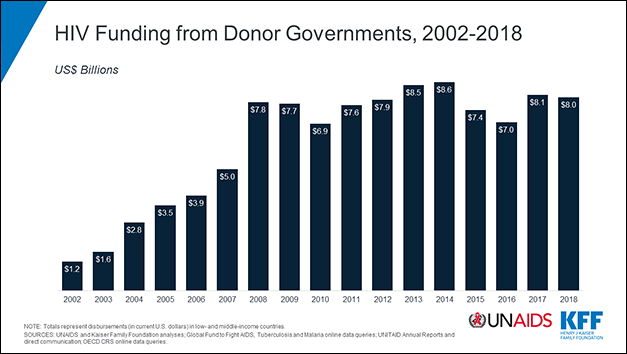UNAIDS’s Global AIDS Update report 2019 22/07/2019 – Posted in: Daily News – Tags: AIDS, HIV
UNAIDS’s Global AIDS Update report 2019
For: Preliminary & Mains
Topics covered: Shortage of Funds to tackle HIV and AIDS, UNAIDS, Highlights of the report
News Flash
UNAIDS says, for the first time, there’s a shortage of funds to tackle HIV and AIDS globally.
- The report notes that global funds for tackling AIDS and HIV have fallen by almost $1 billion.
Highlights
- The report shows that there has been disparate progress both regionally and amongst focus groups in tackling HIV/AIDS.
- AIDS-related deaths have declined by 33% since 2010.
- AIDS-related deaths have increased by 5% in Eastern Europe and Central Asia and by 9% in the Middle East and North Africa.
- The unequal progress in terms of curbing and tackling HIV and AIDS-related deaths is noted.
- High-risk groups— gay men, transgender people, sex worker, intravenous drug users, and prisoners are still excluded.
- In 2018, 95% of new HIV infections in the aforementioned regions have been from these groups.
- Less than 50% of the high-risk groups were reached out to with HIV prevention services in more than half of the countries.
- High-risk groups account for 54% of the new HIV infections globally.
Why the shortage of funds?
- It is due to a global fund crunch and domestic efforts lagging the scale required.
- As of 2018, $19 billion was available for AIDS response— $7.2 billion less than the required $26.2 billion needed to be raised by 2020.
- Since 2010, donor governments, other than the United States, significantly reduced their funding for HIV.
Steps taken
- The UN has called for donors to give at least $14 billion to the Global Fund to Fight AIDS, TB, and Malaria.
- If donors and political leadership of developed countries don’t take the lead in replenishing AIDS funding, realizing the Sustainable Development Goal on health will be difficult—curbing HIV/AIDS to the desired level might take longer than 2030, leading to a higher burden from the infection.
- Half of the 14 donor governments have increased their spending on global HIV efforts from 2017 to 2018. The United States remains the world’s largest donor for HIV.
- UNAIDS unites the efforts of 11 UN organizations—UNHCR, UNICEF, WFP, UNDP, UNFPA, UNODC, UN Women, ILO, UNESCO, WHO, and the World Bank—and works closely with global and national partners towards ending the AIDS epidemic by 2030 as part of the Sustainable Development Goals.
HIV
- HIV (human immunodeficiency virus) is a virus that attacks cells that help the body fight infection, making a person more vulnerable to other infections and diseases.
- It is spread by contact with certain bodily fluids of a person with HIV, most commonly during unprotected sex (sex without a condom or HIV medicine to prevent or treat HIV), or through sharing injection drug equipment.
- If left untreated, HIV can lead to the disease AIDS (acquired immunodeficiency syndrome).
- The human body can’t get rid of HIV and no effective HIV cure exists. So, once you have HIV, you have it for life. However, by taking HIV medicine (called antiretroviral therapy or ART), people with HIV can live long and healthy lives and prevent transmitting HIV to their sexual partners.
- There are effective methods to prevent getting HIV through sex or drug use, including pre-exposure prophylaxis (PrEP) and post-exposure prophylaxis (PEP).
AIDS
- AIDS is the late stage of HIV infection that occurs when the body’s immune system is badly damaged because of the virus.
- Without HIV medicine, people with AIDS typically survive about 3 years.
Source: Financial Express
You can follow us on LinkedIn and on Instagram (Diligent IAS) for more updates related to IAS Preparation/ Study Material, Subscribe to our Facebook Page and Youtube Channel- Diligent IAS
Also, read more Daily News Updates
- The Right to Information (Amendment) Bill, 2019
- International Court of Justice
- The merger of CTDP with the BoT
- DNA Technology (Use and Application) Regulation Bill, 2019


